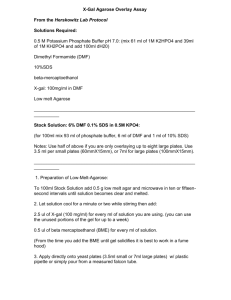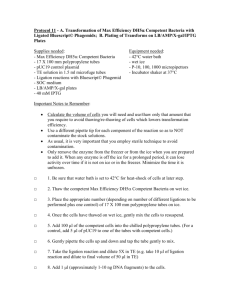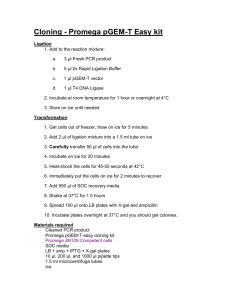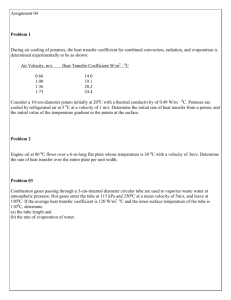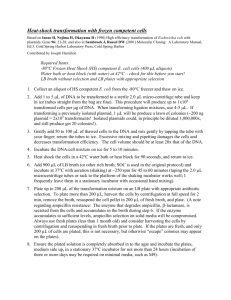7/23/03 - MassBioEd
advertisement
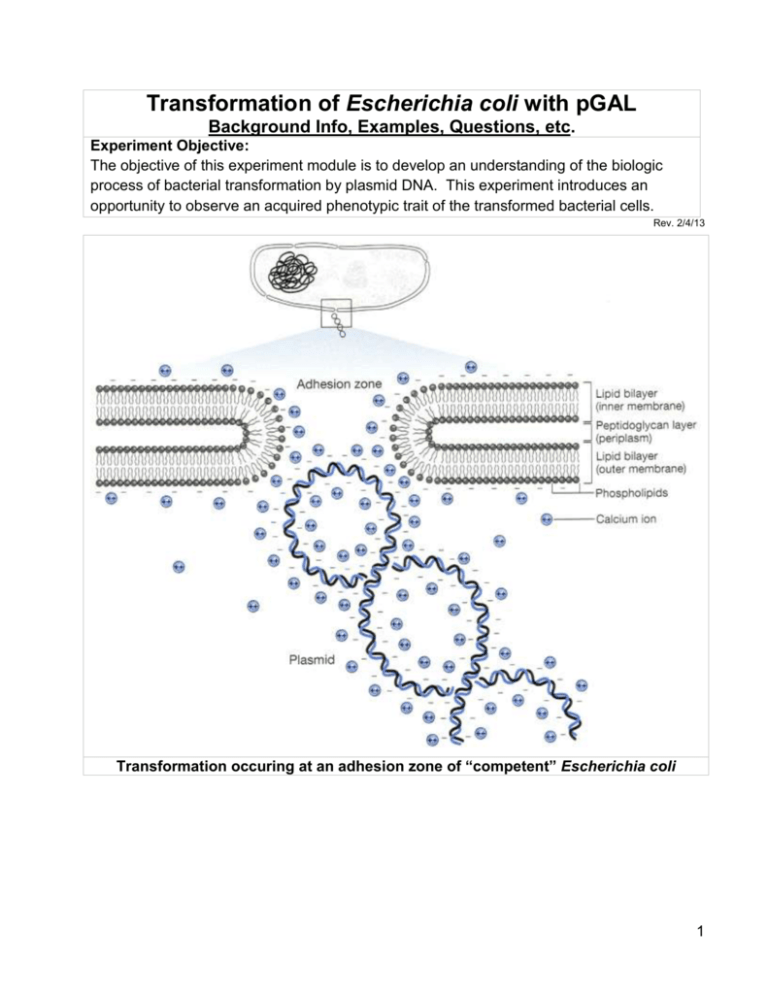
Transformation of Escherichia coli with pGAL Background Info, Examples, Questions, etc. Experiment Objective: The objective of this experiment module is to develop an understanding of the biologic process of bacterial transformation by plasmid DNA. This experiment introduces an opportunity to observe an acquired phenotypic trait of the transformed bacterial cells. Rev. 2/4/13 Transformation occuring at an adhesion zone of “competent” Escherichia coli 1 The Experiment: Many different plasmids serve as useful tools in molecular biology. One example is the pGAL plasmid which contains 6751 base pairs and has been cleverly modified by genetic engineering. In the cell, it does not integrate into the bacterial chromosome, but replicates autonomously. Map of pGAL In this experiment, students will transform host bacterial cells with a plasmid DNA. The transformants exhibit a blue color and acquire antibiotic resistance, due to the incorporation and expression of b-galactosidase and ampicillin resistance genes respectively. The number of transformants will be counted and the transformation efficiency will be determined. The plasmid pGAL contains the E. coli gene which codes for the enzyme β-galactosidase. Since the host E. coli does not contain a β-galactosidase gene, only cells transformed by pGAL will produce functional β-galactosidase. In the presence of artificial galactosides e.g. 5-Bromo-4 Chloro 3-indolyl-β-D-galactoside (X-Gal), pGAL-containing colonies appear blue when colorless X-Gal is cleaved into a colored product. Enzymatic cleavage of lactose by β-galactosidase 2 Transformation by pGAL is also demonstrated by resistance to ampicillin. E. coli host cells used in this experiment are sensitive to ampicillin. pGAL contains the “ampr” gene that encodes for the enzyme β-lactamase which diffuses into the surrounding medium and inactivates ampicillin. - With time, small white colonies may appear around a large blue colony. Cells in those small "satellite" or "feeder" colonies are not resistant to ampicillin and have not been transformed with the pGAL plasmid. They are growing in a region of agar where the βlactamase from the pGAL-transformants has diffused and inactivated the antibiotic ampicillin. The number of satellite colonies increases if the concentration of ampicillin is low or if the plates have incubated for extended times. "Satellite" colonies about colonies of pGAL-transformed E. coli 3 Too much was TOO MUCH! – Plates inoculated with too many transformants Just Right! 4 Experiment Results and Analysis - Address and record the following in your laboratory notebook or on a separate worksheet: Before starting the Experiment: • Write a hypothesis that reflects the experiment. • Predict experimental outcomes. During the Experiment - Data Collection - Observe the results you obtained on your transformation and control plates: • Record (draw) your observations, or photograph what you observe. For each of the plates, record the following: • How much bacterial growth do you observe? Determine a count. (A convenient method to keep track of counted colonies is to mark the colony with a lab marking pen on the outside of the plate. ) • What color are the bacteria? • Why do different members of your class have different transformation efficiency values? • If you did not get any results, what factors could be attributed to this fact? Following the Experiment: • Determination of Transformation Efficiency - Transformation efficiency is a quantitative determination of how many cells were transformed per 1 µg of plasmid DNA. In essence, it is an indicator of how well the transformation experiment worked. You will calculate the transformation efficiency from the data you collect from your experiment. (Calculation of transformation efficiency is explained below) • Formulate an explanation from the results. • Determine what could be changed in the experiment if the experiment were repeated. • Write a hypothesis that would reflect this change. Experiment Results and Analysis Answer these questions BEFORE analyzing your results. 1. On which plate(s) would you find only genetically transformed bacterial cells? Explain. 2. What is the purpose of the control plates? Explain the difference between each and why it is necessary to run each. 3. Why would one compare plates “AMP/X-GAL … - PLASMID” and “AMP/X-GAL … +PLASMID”? Answer these questions AFTER analyzing your results. 1. Did you observe any satellite colonies? Why are the satellite,feeder colonies white? 2. Why did the competent cells which did not receive DNA (control) fail to grow on the plates containing ampicillin? 3. Why are there so many cells growing on the X-GAL plate? What color are they? 4. What evidence do you have that transformation was successful? 5. What are some reasons why transformation may be unsuccessful? 5 Example Photo Identification Label: TUES 8/4/09 - Followed Directions – Properly labeled plates & tape, protocol steps 6 &11? Type of Media Treatment Your Initials Date Initials and the date on the tape Discuss your results. Was your experiment successful? In contrast to the other students who performed the same experiment, how successful was your attempt? ?... Answer will vary for individual students Review the notes that you should have taken as you performed the experiment. If your experiment was unsuccessful, or marginally successful, offer plausible explanations for your results. ?... Answer will vary for individual students 6 Another plasmid is also available in kits designed to teach bacterial transformation. Transformation with pGLO produces colonies that glow under UV radiation, rather than the blue colony phenotype produced by pGAL. In the experimental results below, assume that the pGLO was used at a concentration of 0.1 g/L. Calculate the efficiency for each of the four experiments below. Explain how you achieved your answer, i.e. show the math. Experiment #1 Given: 0.1 µg/µl plasmid, 250 µl CaCl2, 250 µl LB broth, 10 µl of plasmid added to culture, 100 µl of solution from the reaction tube spread on agar plate Results: 44 colonies on the + plasmid ampicillin plate a. Determine mass of the plasmid added to the “+ plasmid” transformation reaction tube. 0.1 µg/µl x 10 µl = 1.0 µg plasmid b. Determine the concentration of plasmid in the reaction tube 1.0 µg (a) _______________ = 0.00196 µg plasmid/µl (250 µl LB broth + 10µl Plasmid + 250µl CaCl2) c. Determine the mass of plasmid in the solution added to the agar plate 0.00196 µg plasmid/µl x 100 µl = 0.196 µg plasmid d. Determine the number of colonies on the “+ plasmid” LB/Amp plate per µg of plasmid 44 transformed colonies = 225 colonies per µg of plasmid 0.196 µg plasmid Experiment #2 ? Experiment #3 ? 7 Experiment #4 ? Assuming that the aliquot of pGLO that you used had a concentration of 0.1 g/L, calculate the efficiency of your experiment. Explain how you achieved your answer, i.e. show the math. ?... Answer will vary for individual students What phenomenon can be observed on this plate? Offer at least one plausible explanation for such a result. Satellite colonies - Ampicillin is not “bactericidal” antibiotic … after extended incubation, the E. coli that were not transformed will grow into colonies. The ampicillin in the plate was eventually destroyed by the beta-lactamase that was produced by the successful transformants (by their expression of the bla gene on pGLO) gmuller@framingham.edu 8 Transformation of Escherichia coli with Plasmid DNA (pGAL) Laboratory Protocol Rev. 2/4/13 Transformation occuring at an adhesion zone of “competent” Escherichia coli Each Lab Station of 2 Students Will Need: • Marker pen Optional • Sterile disposable loops • Foam microtube holder/float • Micropipettes (p20 and p200) and Pipette tips • Transfer pipettes vs. • Biohazard disposal container Transfer pipettes Media Plates • 1 LB/X-gal agar plate (w/ no stripe) • 2 LB/X-gal/Amp agar plates (“striped”) • Microcentrifuge tube containing 25 µL pGAL plasmid (P) on ice • Microcentrifuge tube containing 25 µL CONTROL BUFFER (C) on ice • Microcentrifuge tube containing 700 µL “competent” E. coli cells (Ec) on ice • Microcentrifuge tube containing 1500 µL LB (“recovery”) broth (RB) The Lab Will Also Need: at room temp • Ice-water bath(s) • Preheated 42ºC water bath • 37ºC incubator 9 10 1. Label Tubes a. Label the “C” (for CONTROL BUFFER) microcentrifuge tube on its cap w/ your initials b. Label the “P” (for pGAL DNA) tube w/ your initials c. Place both tubes back on ice 2. The Negative Control a. Add 0.25 mL (250 µL) of E. coli cells (Ec) into the “CONTROL BUFFER” (C) tube b. Mix by tapping c. Place the tube back on ice 3. The Experimental Transformation a. Add 0.25 mL (250 µL) E. coli cells (Ec) into the “pGAL DNA” (P) tube b. Mix by tapping c. Place the tube back on ice e. Discard the used Ec tube into the biohazard disposal container 4. Incubate on Ice Incubate both tubes on ice for a minimum of 10-15 minutes (for up to 45 minutes) 11 5 & 6. Heat Shock the Bacteria* - At the end of the 10-15 minute incubation on ice: a. Bring your ice bath with the “CONTROL” (C) tube and the “pGAL” (P) tube to the 42ºC water bath b. Transfer both tubes into the water bath for exactly 90 seconds c. After the 90 second incubation, immediately ICE 420C/90 sec ICE place both tubes back on ice for a 2 minutes * For best results, the transfer from the ice to the 42ºC water bath and back to the ice must be rapid 7 & 8. Add “Recovery” LB Broth - After 2 minutes (step 5c, above), remove the tubes from ice, then … a. Add 750µL of LB broth into the “CONTROL” (C) tube and close it b. Add 750µL of LB broth into the “pGAL” (P) tube and close it c. Mix both tubes by inversion STOP POINT - After you have added the broth to the two tubes, you can leave the tubes at room temperature overnight then refrigerate until you are ready to use them - Tubes may remain in refrigerator for a week or more - Let tubes warm up at room temperature for a half hour before plating 9. “Recovery” Incubate the tubes at at 37oC for 30 minutes (or at room temperature for >60 minutes) 12 10. Label Plates (during the step 9 “Recovery” period) While the tubes are incubating, label three plates on their bottoms (not on their lids) Label each plate on its bottom (agar side): - Type of Media: X-gal (w/ no stripe)* or LB/X-gal/Amp (“striped”)* - Treatment : “C” (i.e. CONTROL) or “P” (i.e pGAL)* - Your Name/Initials - Today’s Date * i.e. Label the three plates as: - X-gal … C - X-gal/Amp … C - X-gal/Amp … P 11 - 16. Inoculate the Agar Plates with Bacteria Using a micropipette and a fresh tip each time, Use a loop to spread the inocula transfer bacteria from tubes to plates: a. Transfer 250 µL from the “CONTROL” (C) tube to the “LB/X-gal/CONTROL” plate b. Transfer 250 µL from the “CONTROL” (C) tube to the “LB/X-gal/Amp/CONTROL” plate Or simply rock the plate to spread the inocula c. Transfer 250 µL of the transformation from the “pGAL” (P) tube to the “LB/X-gal/Amp/pGAL” plate 13 17 - 22. Incubate the Plates to Allow Bacterial Growth a. Tape your three plates together & Write your name(s) and today’s date on the tape b. Wait 15-20 minutes before turning plates upside down c. Incubate plates for 19-24 hours at 37°C 23 - 24. Observe and Analyze 14 When you are finished the lab exercise, wash your hands with soap and water! gmuller@framingham.edu 15 Transformation of Escherichia coli with pGAL Teacher Preparation The Day the Kit Is Received: Unpack & Store Components in Frig/Freezer Rev. 2/4/13 Preparation of Competent E. coli Cells: The Day Before the Lab: Reconstitute E. coli a. Add 6 mL of “Cell Reconstitution Medium” (Component F) to the vial of lyophilized E. coli cells (stored in the frig) b. Replace stopper, mix by inverting until the freeze dried plug is dissolved, then shake vigorously c. Incubate at 34-37ºC for 16-24 hr (overnight, optimally for 19 hr) The Day of the Lab: Induction of Competency a. Completely thaw the “competency induction solvent” (Component G) and store on ice (if there is a white precipitate, warm if 37ºC water bath, then place on ice) b. Mix by inversion to resuspend the reconstituted E. coli cells (above) and place on ice for 10 min c. Add 3 mL of cold competency induction solvent to the reconstituted E. coli cells (competency induction solvent will be viscous, “none” should remain in the pipette) d. Mix by inversion to form a uniform suspension e. Incubate cells on ice for a minimum of 30 min (for up to 3 hr) Day of the Lab (before students arrive): Preparation of Aliquots of E. coli Cells a. Mix cells by inversion to form a uniform suspension b. Aliquit 0.7 mL (700 L) of cells into ice-cold microcentrifuge tubes c. Cap, label them as “Ec” and immediately place tubes back on ice (can hold them on ice for up to 3 hr) 16 d. Remember to Prepare the 42oC water bath and ice-water buckets for class 17 Preparation of Agar Plates: 1-2 Days before the Lab: • For optimal results, prepare plates two days prior to plating and set aside the plates inverted at room temperature • If they are poured more than two days before use, they should be stored inverted in the refrigerator – when needed, remove the plates from the refrigerator and store inverted for two days at room temperature before use vs. • If plates will be used within two days, store in a sealable plastic bag so the plates will not dry out - store at room temperature, inverted) vs. • “Cure” for 2 days at room temperature, then bag and store in the refrigerator Melt the ReadyPour™ Medium a. Equilibrate a water bath at 60°C b. Loosen, but do not remove, the cap on the ReadyPour™ medium bottle (to allow for the venting of steam during heating) c. Squeeze and vigorously shake the plastic bottle to break up the solid agar into chunks d. Heat the bottle of ReadyPour medium by one of the methods below (when completely melted, the amber-colored solution should appear free of small particles) - Microwave method: • Heat the bottle on High for two 30 second intervals • Using a hot glove, swirl and heat on High for an additional 25 seconds, or until all the medium is dissolved • Using a hot glove, occasionally swirl to expedite melting - Hot plate method: • Place the bottle in a beaker partially filled with water. • Heat the beaker to boiling over a hot plate or burner. • Using a hot glove, occasionally swirl to expedite melting. e. Allow the melted medium to cool to 60°C, it will be warm to the touch, not burning hot (placing the bottle in a 60°C water bath will allow the agar to cool, while preventing it from prematurely solidifying) 18 Preparation of Agar Plates (continued): “Pour” the Plates - Add reagents to medium which has been cooled to60°C - hot medium will cause reagents such as ampicillin to rapidly decompose a. Open both sleeves of 20 plates; make 4 stacks of 10 plates b. Thaw and add all of the “X-Gal solution” (component E) to the medium; Recap bottle and swirl to mix c. Use a fresh 10 mL pipet and a pipet pump to “pour” 10 LB/X-Gal “control” plates, 5 mL each (save the pipet for step e) d. Add the ampicillin powder (component D) to the remaining medium; recap the bottle and swirl to completely dissolve the ampicillin e. Use the 10 mL pipet from step c and a pipet pump to “pour” 20 LB/X-Gal/Amp plates, 5 mL each f. Use a lab marker pen "stripe" the sides of the 20 LB/X-Gal/Amp plates (to provide an easy method of differentiating between plates with ampicillin vs. plates without ampicillin) g. Allow the agar to cool and resolidify 19 Preparation of Aliquots of Buffers, pDNA, etc.: Day of the Lab (before students arrive) vs. 1-2 Days before the Lab: Preparation of Aliquots of Control Buffer and pDNA a. Thaw the tubes of “supercoiled pGAL DNA” (component B) and “control buffer” (component C) on ice (before dispensing, tap the tubes to knock all of the reagents to bottoms of the tubes) b. Using an micropipetter, dispense 25 μL of the pGAL DNA into each of 10 microcentrifuge tubes; cap the tubes, label them as “P” (for pGAL DNA), and place them on ice - Rock the petri plate back and forth to obtain full coverage - Pipet carefully to avoid forming bubbles - if the molten medium contains bubbles, they can be removed by passing a flame across the surface of the medium c. Using an FRESH micropipet tip, dispense 25 μL of the control buffer into each of 10 microcentrifuge tubes; cap the tubes, label them as “C” (for Control Buffer), and place them on ice - The aliquots of “pGAL DNA” and “control buffer” may be prepared in advance, refrozen and thawed in ice the day of the lab Preparation of Aliquots of Recovery Broth a. Dispense 1.5 mL “Recovery Broth” into 10 sterile tubes labeled "RB" b. Cap the tubes and refrigerate if not to be used immediately - Optionally,set up a classroom pipeting station gmuller@framingham.edu 20 10 Agar plates with X-GAL no stripe plates: 5 ml each - ReadyPour medium without ampicillin 20 Agar plates with X-GAL and AMP striped plates: 5 ml each - ReadyPour medium with ampicillin Summary of Reagent Preparations Dispense 10 plates Agar plates with X-GAL (No Stripe) 5 ml 20 plates Agar plates with AMP and X-GAL (Striped) 5 ml 10 tubes pGAL DNA 25 μl on ice 10 tubes Control Buffer 25 μl on ice 10 tubes Cells 0.7 ml on ice Each Group Requires: 1 tube pGAL™ DNA 25 μl on ice 1 tube Cells 0.7 ml on ice 1 tube Control Buffer 25 μl on ice 1 agar plate - no stripe 2 agar plates - striped 4 sterile 1 ml pipets 2 sterile inoculating loops 1 tube Recovery broth (optional) 1.5 ml 2 micropipet tips (if using automatic micropipets) 21
